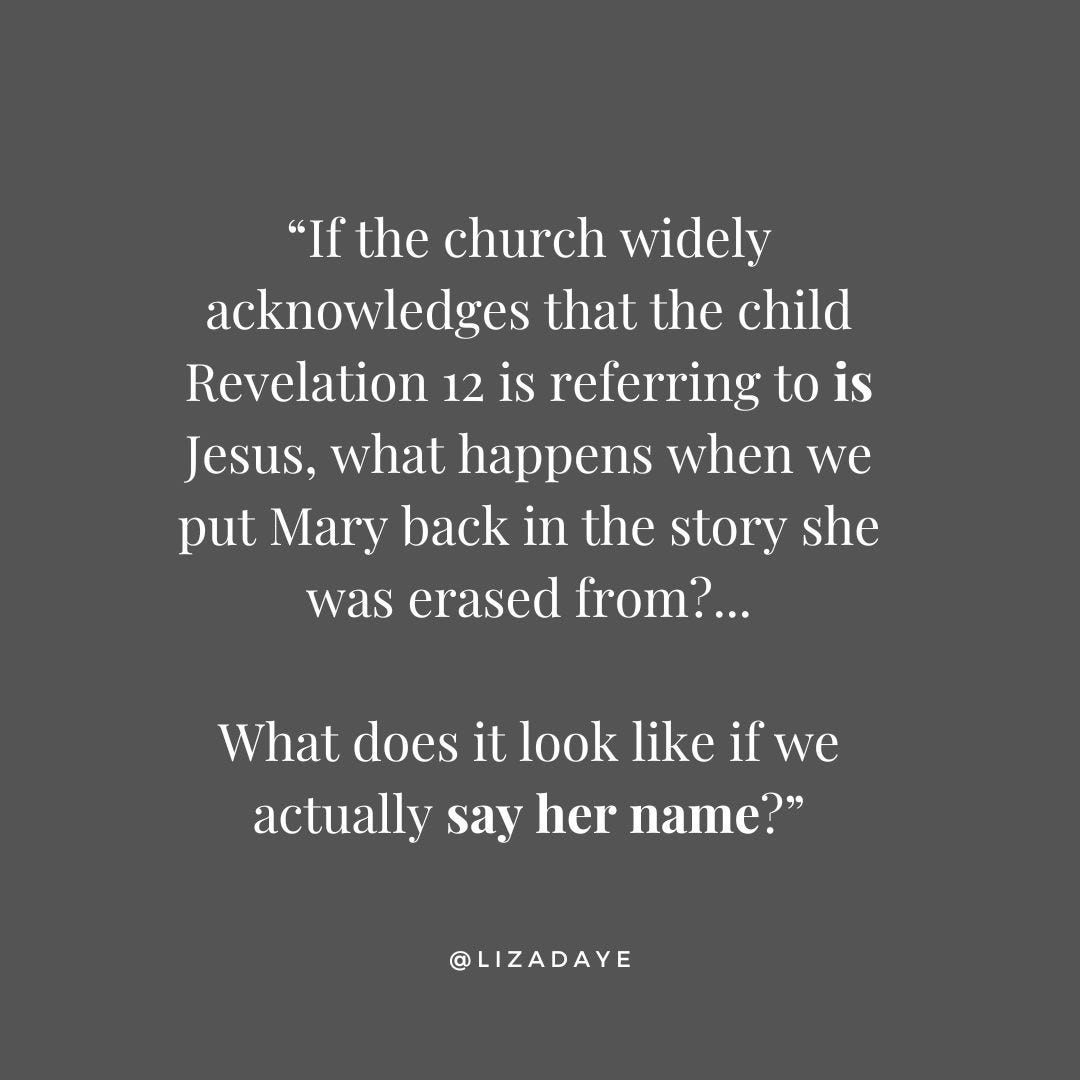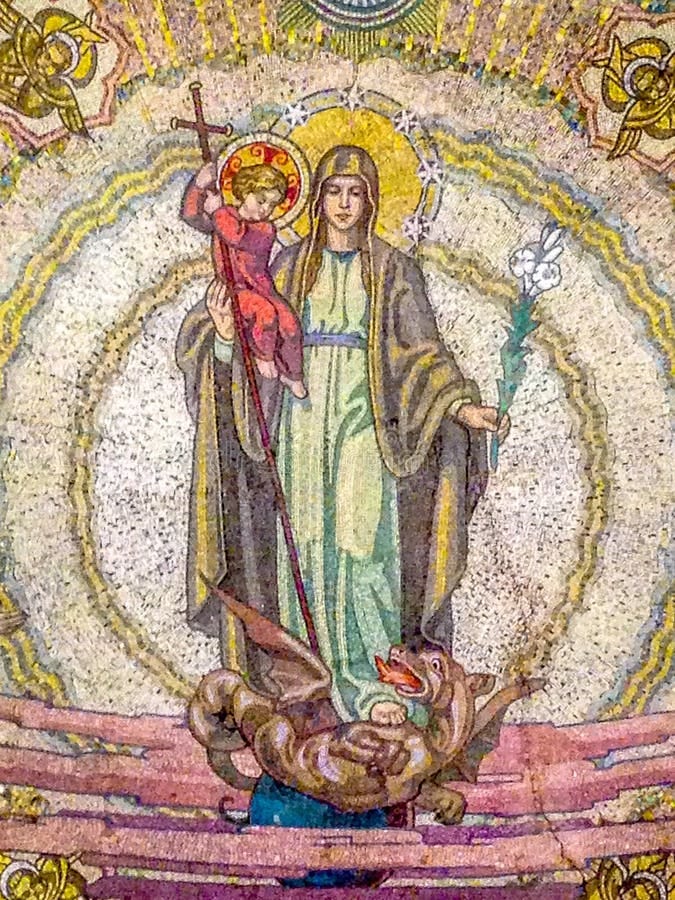“And a great sign appeared in heaven: a woman clothed with the sun and moon beneath her feet and on her head a crown of twelve stars.
She was with child, and she cried out, being in labor and in pain to give birth.
Then another sign was seen in heaven: behold a fiery red dragon with his seven heads, 10 horns, and on his head were several crowns.
And his tail swept across the sky and dragged away 1/3 of the stars from heaven, flinging them to earth.
And the dragon stood in front of the woman who was about to give birth, so that when she gave birth so that when she gave birth, he might devour her child.
And she gave birth to a Son, a male child who is destined to shepherd all of the nations with an iron rod; and her Child was caught up to God and to His throne.”
Revelation 12:1-5
Now. There’s a lot here. I admit that in advance. Any biblical scholar will tell you as much. But how we interpret passages like this one tells us a lot about how carefully we’re both exegeting and imagining. The reality is that the book of Revelation is mysterious in nature, wrapped in themes of subversion, empire, and uprising, but this, this right here is a birth story. And it’s clearly about Jesus.
Yet the reality is that in almost all of my bible commentaries penned by 19th and 20th century white men, this break in John’s revelation narrative is relegated as merely metaphorical. In service of their desired eschatological arguments, the woman depicted her is often representative Israel or the church or even Eve, and there’s often a complicated display of theological gymnastics to support a variety of theological frameworks.
And the question I keep coming back to is: ““If the church widely acknowledges that the child Revelation 12 is referring to is Jesus, what happens when we put Mary back in the story she was erased from?...
What does it look like if we actually say her name?”
I am not purporting in any way to be an expert on either Mariology or the book of Revelation, but I am suggesting that writing her out of the story supports a theological framework that subjugates women, particularly in a passage that likely has multiple layers and multiple intersecting and mutually informing interpretations. So, while acknowledging that, let’s explore just one of them.
So, let’s work through this reimagining of Christ’s birth together.
First, let’s examine this Greek word for “signs”: σημεῖον.
Why is this word significant? Because in almost all 77 of its NT occurrences, this word is communicating something literal and physical.
Here, we have a woman with a crown. An actual woman, with an actual crown, worthy of actual honor. And what does it mean to be clothed with the sun and moon beneath her feet rather than above her feet? She’s naked. This is how we women birth. Not wrapped in anything but rather, imagine Mary birthing the maker of the universe between the very sun and moon that he himself originally separated. Once again, Jesus is separating day from night, creating and recreating both in and through the incarnation. Here, at his birth, the word became flesh, because of Mary’s flesh. Literally.
This text has no shortage of callbacks to the Genesis narrative, but I think it’s unhelpful from a doctrinal standpoint to affirm that the second sign is more literal than the first. And while some scholars affirm that the presence of the dragon in verse 4 suggests that Herod’s plan to assassinate the young Christ was satanically inspired, I don’t think that’s what John is saying here. While I don’t disagree, the text says that the dragon stood in front of the woman before giving birth. Herod gave his decree after.
So, what would it mean for our nativity scenes and our Christmas carols and our theological imagination for Mary mother of Jesus, to experience the same literal enmity with the serpent turned dragon as Eve herself literally did in Gen 3:15 from the very beginning.
What if Mary gave birth face to face with the dragon himself?
And as she labored, she challenged evil, by giving birth to everlasting life—by wrapping the light of the world in swaddling clothes and allowing the prince of peace to rest in a manger, while staring down the dragon himself. Why? Because the LORD is salvation. And there he was. Right there. Truly, I can’t imagine a more subversive faith-filled response.
“And she gave birth to a Son.”
Mary. Mary gave birth to Jesus. She didn’t birth the church. Israel didn’t birth Jesus.
Mary birthed Jesus.
“The child is destined to shepherd all of the nations with a rod of iron.”
Mosaic of Mother Mary with Child Jesus Slaying the Dragon at The Church of St. Francis Assisi in New York City.
Why does the iron rod matter? Because most shepherding rods were fashioned from wood. Weapons were fashioned with iron. But this rod isn’t a weapon, it’s a tool to defend the flock from predators, to rescue sheep, and guide them. Jesus could have chosen real a weapon, but he didn’t.
And it is not insignificant that the first preachers of Christ’s arrival were shepherds themselves with wooden rods.
“And Mary’s child was caught up to God and to His throne.”
Verse 5 is a summary. A synecdoche. Christ was born, and Christ resurrected, and this story, Mary is honored.
“God prepared a place for her.”
Throughout the biblical narrative there are themes of barrenness, birth, and brave bold women. And the presence of women in the story almost always indicate that God is trying to communicate something significant, rather than the opposite.
In reimagining the birth of Christ through the lens of John’s vision in Revelation 12, we find a retelling that challenges traditional interpretations that seek to minimize Mary, and it matters that we question the theological frameworks that, inadvertently or too often intentionally, sideline women.
As we daydream about the mystery of the incarnation this Advent season, let's reconsider the significance of Mary's role in contributing to God’s flesh. She wasn’t just a submissive servant. She was subversive, substantial. And what would it mean if these signs that John was writing about aren’t mysterious metaphorical concepts, but what if they’re never before seen revelations of Christ’s birth, theological truth that challenges empirical interpretations of the text — and reveal to us a woman who is deeply honored and worthy of giving birth to the Maker of the universe. Regardless, Mary, the mother of Jesus, is deserving of a central place in Christ’s birth story, not as an unnamed symbol, but as a woman whose embodied role is instrumental in the unfolding drama of redemption for all of creation.
“And a great sign appeared in heaven: Mary clothed with the sun and moon beneath her feet and on her head a crown of twelve stars.
Mary was with child, and Mary cried out, being in labor and in pain to give birth.
Then another sign was seen in heaven: behold a fiery red dragon with his seven heads, 10 horns, and on his head were several crowns.
And his tail swept across the sky and dragged away 1/3 of the stars from heaven, flinging them to earth.
And the dragon stood in front of Mary who was about to give birth, so that when Mary gave birth, he might devour her child.
And Mary gave birth to a Son, a male child who is destined to shepherd all of the nations with an iron rod; and Mary’s Child was caught up to God and to His throne.”
Revelation 12:1-5
As always, Thanks for reading and supporting my work and I hope you’ll keep the conversation going below. This will be one of my last posts of the year, but y’all can expect some exciting things to come in 2024! One of the simplest ways to support my writing is to sign up for emails, and make sure you’re hanging out with me on IG & Threads. the user name is the same as here :) @lizadaye I hope your holiday is soft and safe. <3 Be blessed friends.









I love this, Liz! I don’t think I’ve never heard that passage in Revelation as being about the literal Mary birthing Jesus, but it makes so much sense. It’s amazing how revisiting some of these texts that are often interpreted through excluding women, actually have so much more to say when you INCLUDE the women.